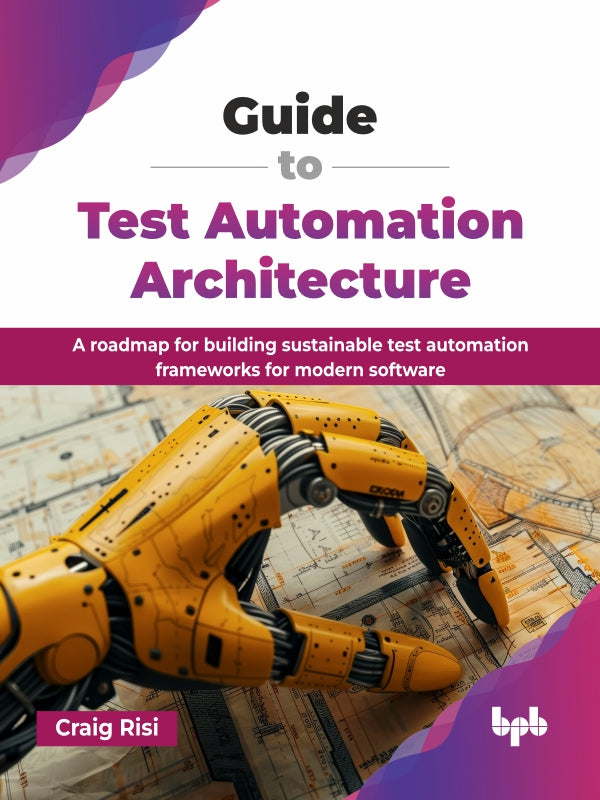Guide to Test Automation Architecture
Couldn't load pickup availability
ISBN: 9789365899702
eISBN: 9789365895407
Authors: Craig Risi
Rights: Worldwide
Edition: 2025
Pages: 344
Dimension: 8.5*11 Inches
Book Type: Paperback

- Description
- Table of Contents
- About the Authors
In the software development domain, test automation has emerged as the cornerstone of delivering reliable applications. This comprehensive guide provides a systematic roadmap for designing and implementing test automation frameworks that transcend tool-specific limitations, ensuring they adapt and endure.
You will learn to apply core software architectural principles—including modularity, loose coupling, and layering—to your test code. The book offers practical guidance on managing test data, orchestrating parallel test executions, and integrating seamlessly with CI/CD pipelines using quality gates. Furthermore, it details how to expand your framework's capabilities to include non-functional testing, such as security, performance, and resilience.
Through detailed case studies, you will gain a clear understanding of what it takes to build a scalable framework from scratch, migrate a legacy system, and foster continuous architectural improvement. With insights into emerging trends, like AI-driven automation and predictive analytics, this book is both a toolkit and a strategic guide. It empowers architects, testers, and developers alike to embrace complexity and lead the way in modern test automation.
WHAT YOU WILL LEARN
● Design a scalable, tool-agnostic framework with architectural patterns.
● The role of software architecture in test automation.
● Building a test automation framework that caters to all types of applications
● Integrate testability into software design using dependency injection.
● Embed automated quality gates into CI/CD pipelines.
● Handling modern testing challenges.
● Leverage AI/ML to create self-healing and predictive test suites.
WHO THIS BOOK IS FOR
This book is for software architects, SDETs, software engineers, and quality engineers responsible for designing and developing test automation frameworks. Readers should have a foundational understanding of programming concepts and software development lifecycle principles before diving in.
Prologue
1. Introduction to Test Automation
2. Understanding Test Automation Frameworks
3. Designing with Architecture in Mind
4. Designing Modular Test Frameworks
5. Testability and Software Design
6. Test Orchestration and Execution
7. Test Data Management
8. CI/CD Integration and Quality Gates
9. Handling Asynchronous and Distributed Systems
10. Security, Performance, and Resilience Testing
11. Overview of Tools Used in Test Automation
12. Case Study: Building a Scalable Framework From Scratch
13. Case Study: Migrating to a Tool-agnostic Framework
14. Case Study: Framework Evolution and Continuous Improvement
15. Embracing AI and ML in Test Automation
16. Emerging Trends and Technologies
17. Conclusion: The Path to Sustainable Test Automation Frameworks
Appendix
Glossary of Terms
A man of many talents, but no sense of how to use them. Craig could be out changing the world but would prefer to make software instead. Probably the reason why Nick Fury refused to take his calls. He possesses a passion for software design, but more importantly software quality and designing systems that can achieve this in a technically diverse and constantly evolving tech world.
Craig has over 20 years’ experience across the development, testing and management disciplines in a variety of software industries, but still feels he learns something new every day. It is that continued change and evolution of the software industry which motivates him to keep learning and finding ways to improve. More than just playing with tech though, it is the people that make a software come together – and so, Craig believes in developing people and empowering them to make a success out of the software they build.
When not playing with software, he can often be found spending time with family, writing, designing board games, or running long distances for no apparent reason. He is also a massive fan of comic books and Star Wars, so if you see him concentrating intensely, he is probably just trying to use the force.
Craig is also the writer of several books and writes regular articles on his blog sites and various other tech sites around the world. He is an international speaker on a wide range of different software development topics.


